Updated July 1, 2023

Introduction to JavaScript Loop Array
The following article provides an outllne for JavaScript Loop Array. In JavaScript, we have different sets of loops structures, and its features are very helpful for creating and validating the web pages for sending the request to the servers. Especially for receiving the response from the servers and it will show in the web page screens. There are different types and ways for JavaScript arrays and it is more complicated to identify which array sequence will be used in the script. Meanwhile, the for loop is one of the basic JavaScript loops like that forEach methods, and its collections own libraries with forEach and also each of its methods. When we use arrays in the script using the iterate method, we will retrieve the data.
Syntax:
In JavaScript, we use a different set of loops in the web page based on the requirements. We will apply it in the scripts but when we validate something on the web page itself it’s very much helpful for “for,while” etc.
<html>
<head>
<script>
var variable name="";
//use any loops for example for and while we used in this script
for(inti=initialize value;condition check;increment/decrement)
{
Some logics;
}
while(variablename condition check)
{
--some logics---
}
</script>
</head>
<body>
</body>
</html>The above code is the basic usage of the loops in JavaScript. When we declare arrays in the script using for loop and forEach we can iterate it for retrieving the values.
How does JavaScript Loop Array work?
The JavaScript loops always iterate with each item in a single array. If we use a multi-dimensional array, we can use forEach, or else we will use multiple ordinary for loops to iterate the elements. Basically, arrays are zero-based index elements which means the first element will start at 0 indexes and it goes on till the declaration will end. Always reference items in the arrays that are specific to the numerical index. It is also starting with 0 indexes and ending with the array lengths. We always use loop statements with three types of expressions initialize the values declared the conditions and increment/decrement the variable it’s the final type of expression.
These type of expressions are executed at the end of each loop execution moreover, it is used to increment the index if we want to iterate the second level of property or field elements also can be nested with the conditions in the for loops and also a main big advantage for to keep the track the elements with a separate type of index variables in the script. If we want to stop the execution of the for loop, we use a break statement or set the index to the array length or the value that will make the script statements no longer values. Also, if we want to omit the conditions in the for loop statement, use the break keyword to terminate the for loop conditions, then the value gets no longer set of the true conditions. The basic loop condition is easy to understand the code logic and satisfies the requirements, and also it takes more memory consumption when compared to other types of loops because it must satisfy the conditions; otherwise, the loops are terminated, and the syntax is also tedious.
When we use nested for loops, it will create and initialize the variables. It satisfied all the nested loop conditions, and it must either increment or decrement the variables. If we use forEach loop, it first uses the native array object for the JavaScript actually forEach loop uses a callback function in the code. It must follow the three types of parameters called element value, element index, and array being traversed in the loop element are current items in the array variable values we use the variable initialization in the loop we must use the initialized variable in the array variable in forEach loop it uses only the element type its not acceptable for the indexes and arrays element is nothing but the values iterating so we should always declare an element that has the parameter type after callback function is executed in forEach loop it also accepts the optional parameter has thisArg keyword we use this keyword for the calling current method or values in the loop count as the variable declaration for counting the values in the particular method in the outside of the scope.
Examples of JavaScript Loop Array
Given below are the examples mentioned:
Example #1
Code:
<!DOCTYPEhtml>
<html>
<body>
<h2>Welcome To My Domain</h2>
<p>Gud day</p>
<p id="demo"></p>
<script>
var t = "";
var n = [34, 41, 76, 2, 13];
n.forEach(sample);
document.getElementById("demo").innerHTML = t;
function sample(v, i, a) {
t = t + v + "<br>";
}
</script>
</body>
</html>Output:
Example #2
Code:
<html>
<head>
<script language="javascript">
document.writeln("<h2>Welcome To My Domain</h2>");
var b = { "First" : [
{ "Name" : "Sivaraman", "Id" : 2 },
{ "Name" : "Arun", "Id" : 3 }],
"Second" : [
{ "Name" : "Kumar", "Id" : 4 },
{ "Name" : "Saran", "Id" : 5 }]
}
var i = 0
document.writeln("<table border = '3'><tr>");
for(i = 0;i<b.First.length;i++) {
document.writeln("<td>");
document.writeln("<table border = '2' width = 37 >");
document.writeln("<tr><td><b>Name</b></td><td width = 27>" + b.First[i].Name+"</td></tr>");
document.writeln("<tr><td><b>Id</b></td><td width = 57>" + b.First[i].Id +"</td></tr>");
document.writeln("</table>");
document.writeln("</td>");
}
for(i = 0;i<b.Second.length;i++) {
document.writeln("<td>");
document.writeln("<table border = '4' width = 67 >");
document.writeln("<tr><td><b>Name</b></td><td width = 50>" + b.Second[i].Name+"</td></tr>");
document.writeln("<tr><td><b>Id</b></td><td width = 50>" + b.Second[i].Id+"</td></tr>");
document.writeln("</table>");
document.writeln("</td>");
}
document.writeln("</tr></table>");
</script>
</head>
<body>
</body>
</html>Output:
Example #3
Code:
<!DOCTYPEhtml>
<html>
<body>
<h2>Welcome To My Domain</h2>
<p id="demo"></p>
<script>
var t = ""
var i = 0;
do {
t += "<br>The given number is " + i;
i++;
}
while (i < 10);
document.getElementById("demo").innerHTML = t;
</script>
</body>
</html>Output:
In the above three examples, we used the loops in different ways of the JavaScript do, while, for, and forEach; we have used do while first to execute the loops once, and after that condition will be checked.
Conclusion
Looping over arrays is the basic fundamental of the codes. Basically, loops always execute the variable like declared normally or in array formats. JavaScript has one of the native ways to iterate the arrays and also use libraries to configure.
Recommended Articles
This is a guide to JavaScript Loop Array. Here we discuss how does JavaScript loop array work with programming examples for better understanding. You may also have a look at the following articles to learn more –




